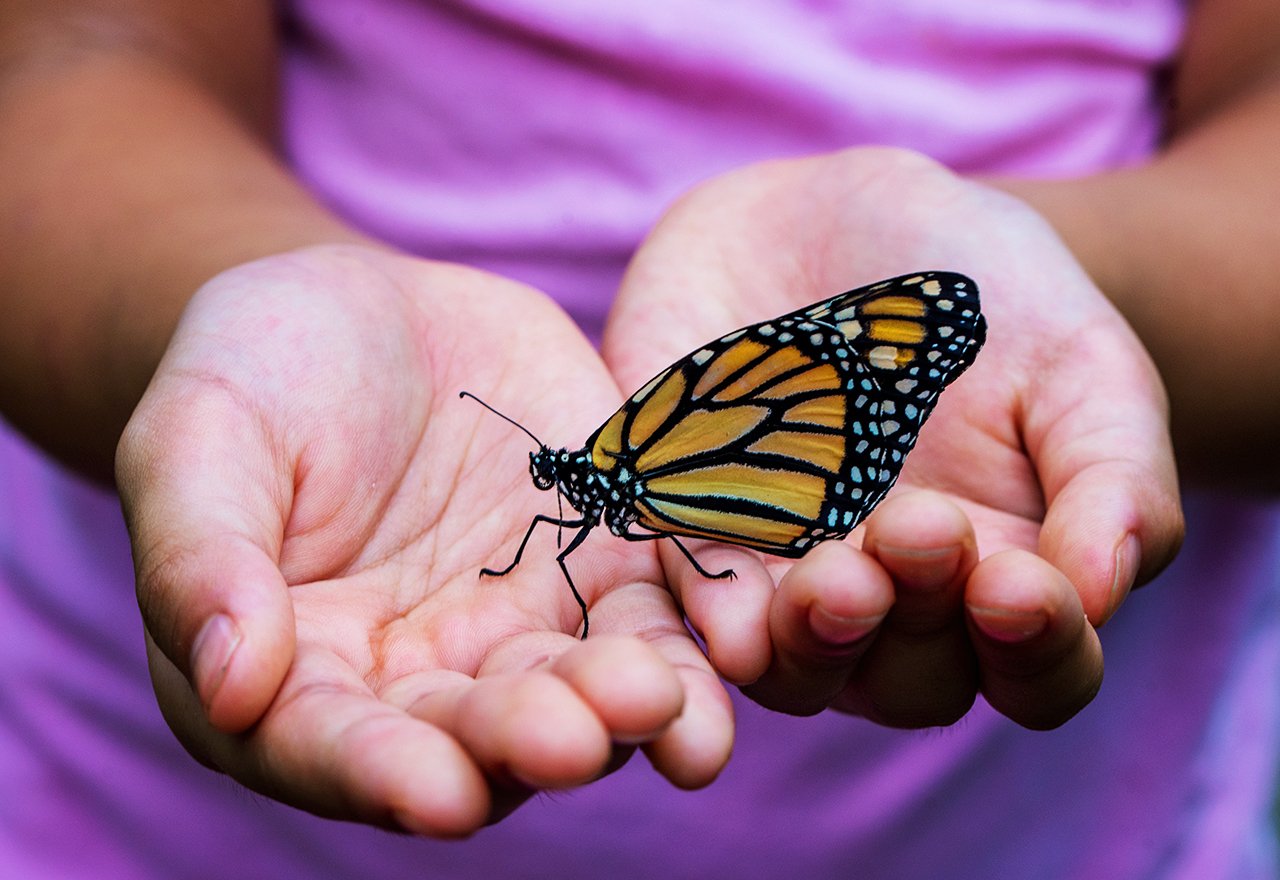How to Help the Monarch Butterflies in their Plight
by Maureen Wise, on August 10, 2019
The monarch butterfly, Danaus plexippus, is perhaps the most well-known butterfly. Their distinct orange and black markings make it easy for children and adults to identify them. Additionally, their huge, annual migration to and from Mexico and California and then to most of the rest of North America is astounding. Here in Ohio, they fly over Lake Erie to get to Canada. But these beautiful butterflies are in danger with their numbers steadily declining. Much of their habitat is being taken away, in addition to their food source. Every family can do their part to help the monarch population rise again.

Monarchs 101
Monarchs, like all butterflies, start out as an egg. Monarch eggs are always laid on on a milkweed plant. Once hatched, their caterpillars, aka larvae, get chubby by exclusively eating milkweed. The caterpillar creates a chrysalis and then emerges as a beautiful butterfly, a story made famous in the book The Very Hungry Caterpillar. Adult monarchs still do feed from milkweed but not exclusively. Milkweed is very important to their entire life-cycle.
Males and females have different characteristics. Male monarch butterflies have two black splotches at the midpoint of their back wings that females lack. The splotches contain scent glands that help the men attract the ladies. The female monarchs also have thicker wing veins and are a darker orange, which is hard to distinguish unless a male is nearby to compare. See their differences here.
Milkweed plants are not eaten by many animals or insects, but those that do, all have orange or red markings like the monarchs. The bright colors act as a warning to predators. Milkweed plants are poisonous or taste bad to other animals and because monarchs are able to eat milkweed, these butterflies taste bad too. The viceroy butterfly, Limenitis archippus, has similar coloring to the monarch to copy this warning system, but are not milkweed eaters. The viceroy are smaller than monarchs and have a slightly different markings, but do not share their taste bad. They are an example of natures copy cats!
The Threat to Monarchs
There are many factors influencing the decline of monarch butterflies. Milkweed plants and monarchs are tightly linked. Without milkweed, the figurehead butterflies’ young can’t survive. Milkweed is often considered, well, a weed and therefore is not often planted, but more often taken out or sprayed with pesticides.
Monarch butterflies are also facing habitat loss, both in mating areas throughout the United States, as well as overwintering areas in Mexico and California. Development and new agriculture are the largest habitat encroachers.

Pesticides, insecticides, herbicides, and fungicides are also affecting the orange and black long-distance travelers, which you can read more about here. Overspray and drift from agricultural areas that are sprayed with pesticides harm or kill both milkweed and the butterflies. The same goes for residential weed control. This is a big reason that Good Nature Organic Lawn Care does not believe in spraying harmful chemicals on lawns. Instead their Organic Foundation Lawn Care Program, uses organic ingredients, such as vegetable proteins, plant extracts, micronutrients, and plant oils to feed your lawn and help it resist insects and weeds naturally. Our goal is to preserve important pollinators, including butterflies.
How You Can be a Butterfly Hero
Planting your own milkweed garden is the easiest and most important way you can help the monarch population grow. The more patches of milkweed out there, the more areas they can lay eggs. Find a spot in your yard with a lot of sun that's sheltered from the wind. Remember that it’s important that pesticides don’t touch this garden. Anything we spray on your yard from Good Nature Organic Lawn care will only help your milkweed plants. There are many varieties of the plant, so be sure to select those that are native to your region and will do the best in your yard. Learn more about which milkweed variety is best here. Then encourage your friends and family to do the same. You can also encourage your local library to plant a butterfly garden, or even your community center. Where else can you see a crop of milkweed plants growing in your area?
Additionally, there are many citizen scientist opportunities to help the monarch. If you happen to be on the US and Mexico’s Pacific coast on Thanksgiving or New Years, you can help enumerate the monarchs through the Western Monarch Counts Program. In the rest of the US, there are counting days throughout the year that you can find with the Monarch Larva Monitoring Project. You can also report sightings and track the famous 3,000-mile migration on the Journey North website. Find more ways to get involved at the Monarch Joint Venture or MonarchWatch.org.
Learn lots more about these pretty creatures at the Nature Conservancy, NatGeo, the US Fish and Wildlife Service or the National Wildlife Federation.
Will you be planting milkweed this Summer? Can you identify a male vs female monarch? Let us know on social media!












